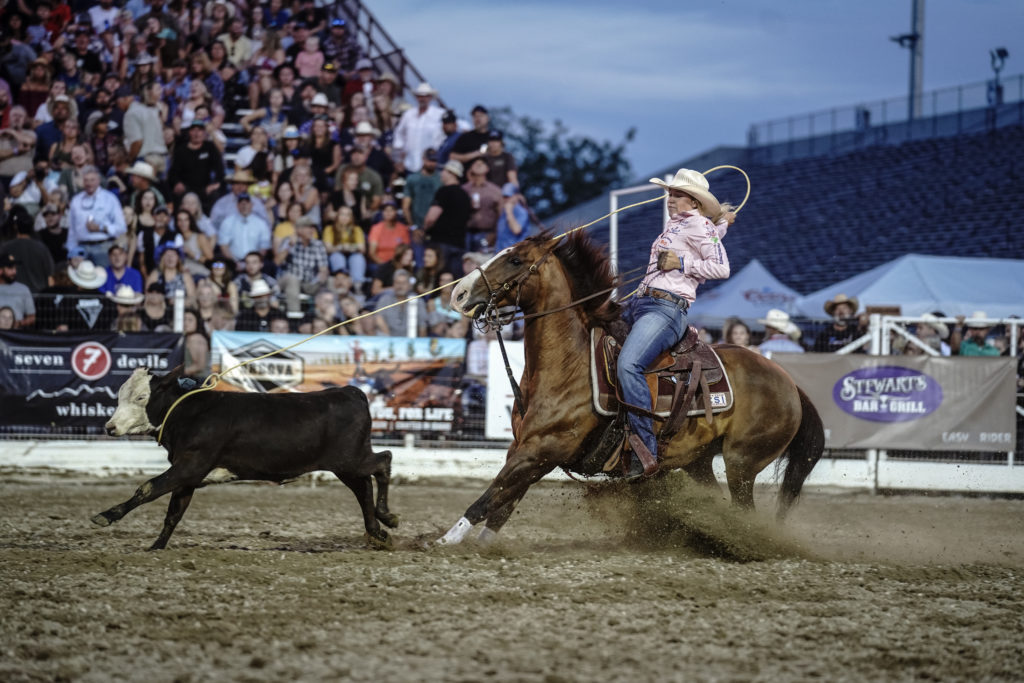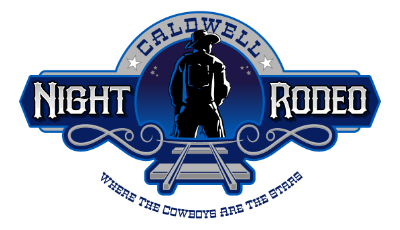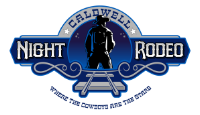Rodeo Event Descriptions
Bareback Riding
With nothing to hold but a “rigging” or suitcase-like handle on a strap secured comfortably behind the horse’s front legs, the cowboy must maintain balance and control while the horse bucks and pitches. A “flank strap” is secured around the horse’s hind end which tells the animal it’s go-time! The ride is judged on the cowboy’s spurring motion in coordination with the horse’s movement, as well as the bucking action of the animal.
A rider is disqualified if he fails to have his heels touching the animal above the point of the horse’s shoulders when it makes its first jump, known as the “mark-out” rule. Additionally, the rider cannot touch any part of the horse or himself during the 8-second ride in the bareback riding event. A high-scoring ride is in the high 80s or 90s out of a possible 100 points.
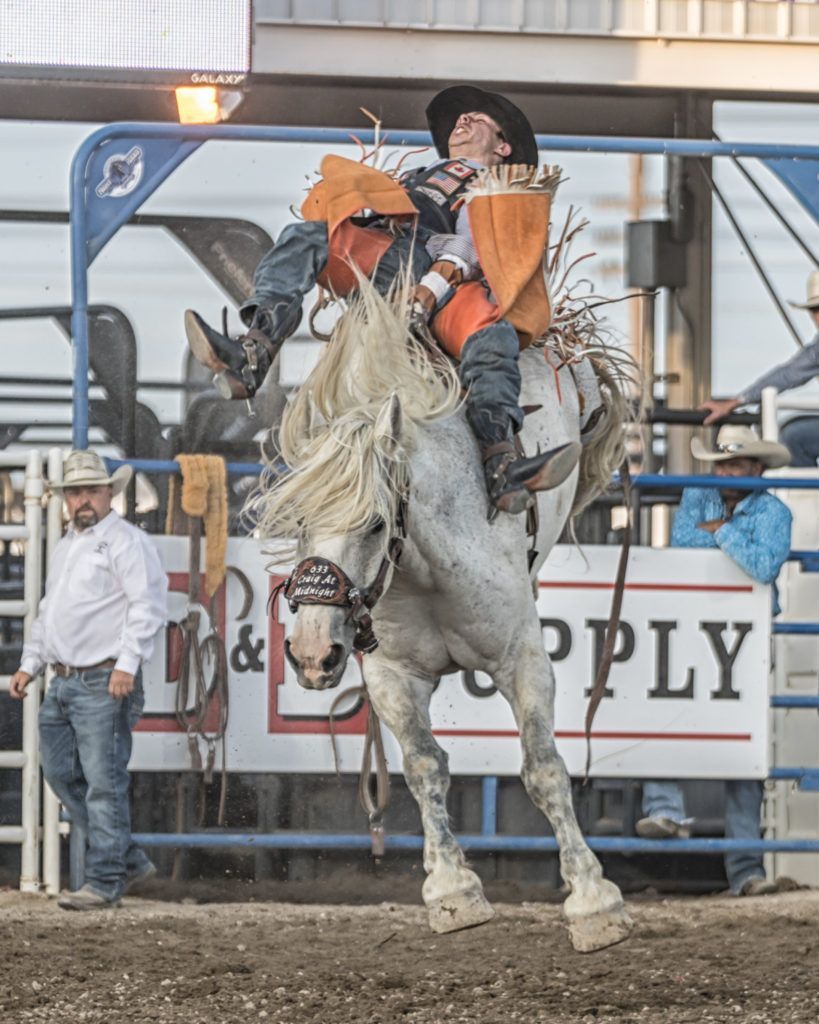
Steer Wrestling
Sometimes referred to as “bulldogging,” steer wrestling is an all-out battle of strength. The cowboy starts out on horseback in a three-sided fenced area known as “the box.” A rope, known as the “barrier,” is attached to the steer and serves as a head start for the animal. Once the cowboy nods to indicate his readiness, the gate is opened and the steer exits the chute. When the steer reaches the end of the rope, the barrier is released and the cowboy takes off in pursuit. If the cowboy leaves before the steer, a 10-second penalty is added to his final time and referred to as a “broken barrier”.
If the cowboy reaches the steer, he dismounts using strength and leverage, slows the animal by digging his heels into the dirt and maneuvers the steer to the ground. In order to catch the sprinting steer, the bulldogger relies on a “hazer”, which is another mounted cowboy running beside the steer. Time stops when the steer is on its side with all four feet pointing in the same direction.
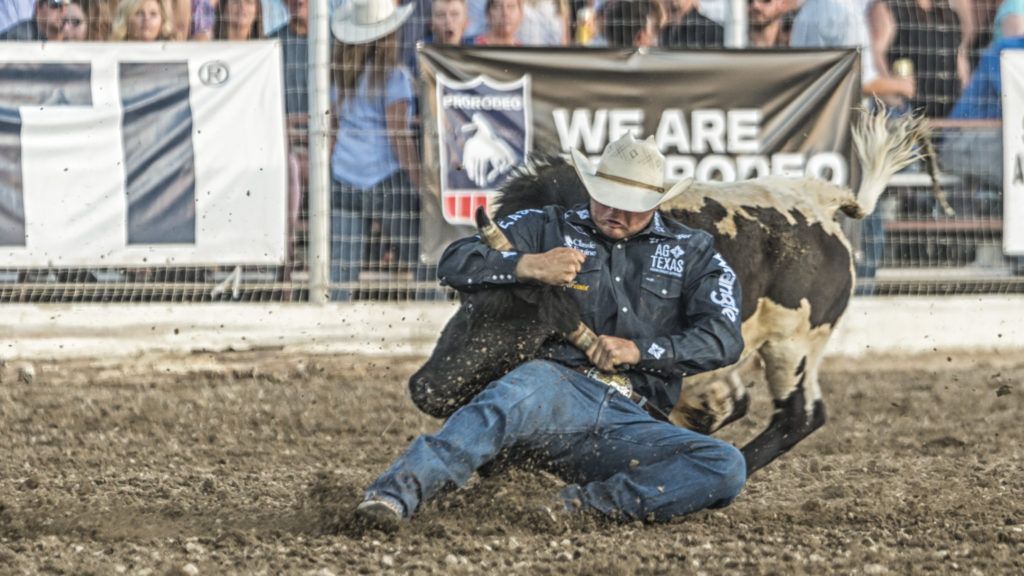
Team Roping
This is the only true team event in rodeo – one “header” who ropes the head of the steer and one “heeler” who ropes the heels, or feet, of the steer. Each contestant begins in their respective “roping box” – a three-sided fenced area with a chute containing the steer in the middle. Similar to Steer Wrestling, a breakaway rope or “barrier” is attached to the steer and released once the steer reaches its advantage point The “broken barrier” rule also applies with a 10-second penalty added to the team’s time.
Once the steer is out, the header leaves the roping box in pursuit of the steer, roping it around the horns, neck, or a horn-neck combination. He then turns the steer quickly to the left so the heeler has a shot at both of its hind legs. The clock stops when their horses are facing each other and their ropes are pulled tightly. If the heeler catches only one leg, a five-second penalty is added. A fast time in the Team Roping is less than 4 seconds.
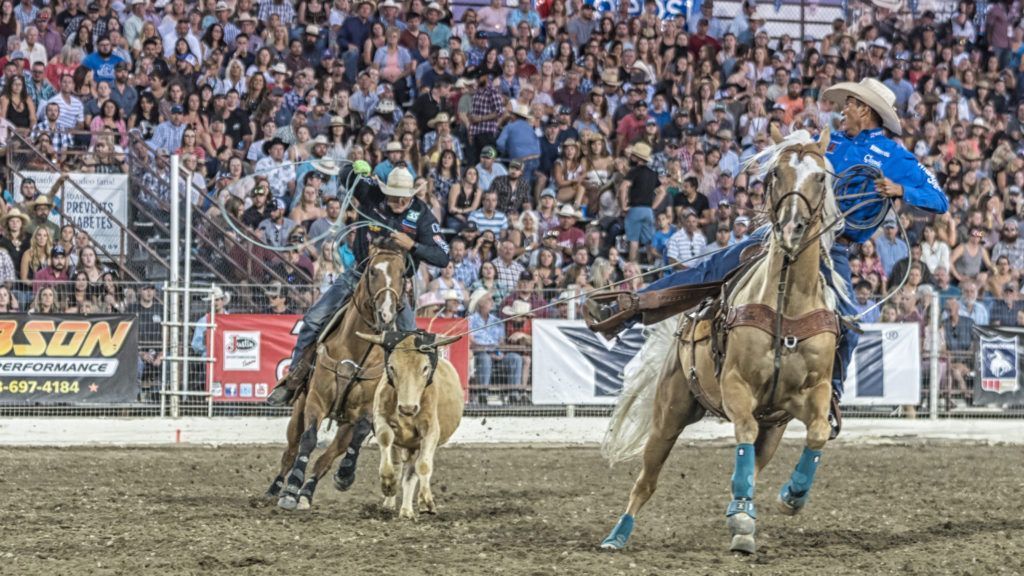
Saddle Bronc Riding
Saddle bronc riding is rodeo’s classic event since it derived from the practice of “breaking” or training saddle horses in the Old West. The contestant sits in a standard saddle attached to the back of the horse – but with no saddle horn.
For leverage, he holds a thick “rein” or rope that is attached to the horse’s halter, which can only be held with one hand. When the gate swings open, the cowboy must adhere to the “mark-out” rule in which he must have his heels touching the animal above the point of the horse’s shoulders when it makes its first jump. Otherwise, the cowboy will be disqualified and given a “no score.” Synchronization with the horse’s movements earns higher scores.
When the horse’s front feet are on the ground, the rider’s heels must be in front of the horse’s shoulders, toes turned out. As the horse resets for its next move, the cowboy brings his heels to the back of the saddle, all the while anticipating the animal’s next jump. If the contestant touches any part of the horse or himself with his free hand during the 8-second ride, he will be disqualified. A high-scoring ride is in the 80s or 90s out of a possible 100 points.
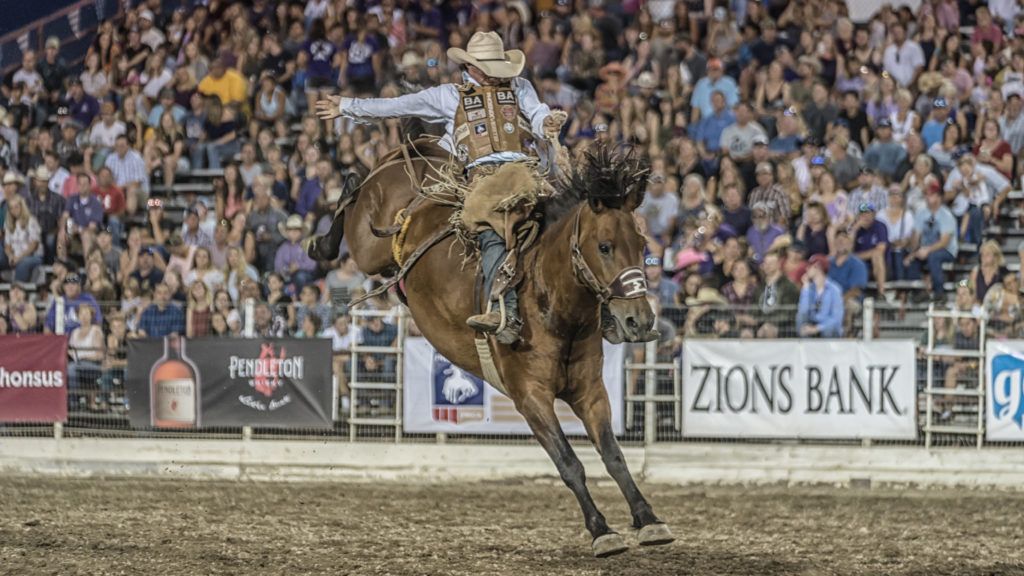
Tie-Down Roping
Like many rodeo events, tie-down roping can be traced back to the working ranches of the Old West. The roper begins his run from “roping box,” with a barrier rope across the open front. The box is adjacent to a chute, containing the calf. One end of the breakaway barrier is looped around the calf and released as soon as the calf reaches its advantage point. If the roper beats the calf out of the chute, a 10-second penalty is added to his final time and considered a “broken barrier.”
Once the calf is caught by the cowboy’s loop, the horse is trained to come to a stop and pull back to remove any “slack” or extra rope to keep the calf still. The cowboy quickly dismounts and sprints down his rope to the calf and turns the calf by hand, referred to as “flanking”. If the calf is not standing when the cowboy reaches it, he must allow the calf to stand before he proceeds to flank it. Once flanked, the roper ties any three of the animal’s legs together with a “pigging string” – a short looped rope.
To signal that his run is complete, the contestant throws his hands in the air. He then remounts his horse and must wait six seconds to ensure that the calf does not kick free. If the calf does not remain tied, the roper receives no time.
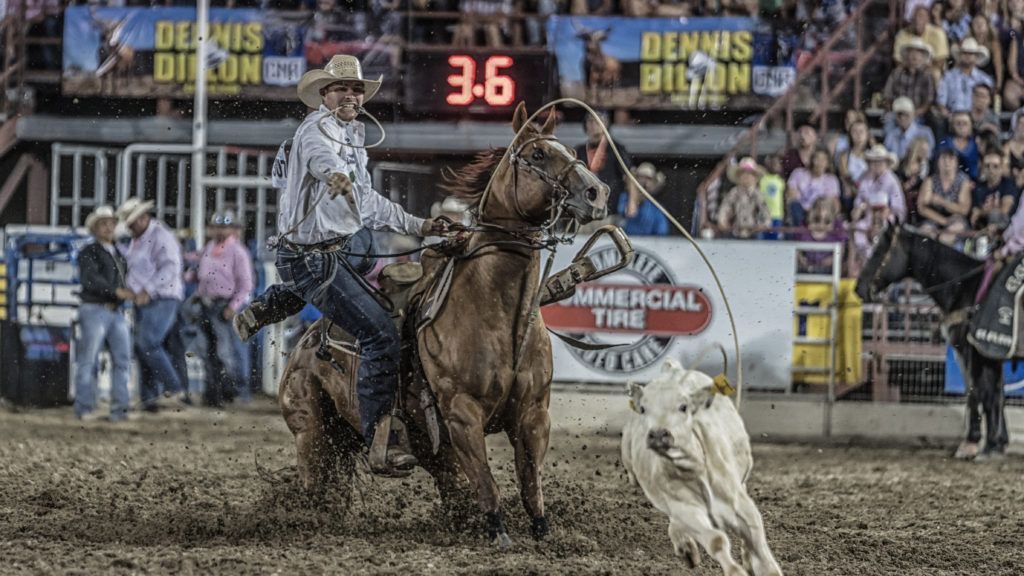
Barrel Racing
Barrel Racing is known as one of the fastest events in rodeo. Arranged in a triangle, barrel racers must run around all three barrels in a pattern known as a “cloverleaf” being careful not to turn one over. Riders may begin on the left or the right barrel first, but the pattern cannot be broken.
Horses must be not only swift, but accurate in their ability to maneuver around the barrels with ease and agility. If the rider or the horse makes contact with a barrel, it can be touched in order to keep it from falling. If not, each fallen barrel adds a penalty of five-seconds to the rider’s final time. The sport is timed to the hundredth of a second.
An “electric eye,” or automatic stopwatch serves as the timer on the arena floor and starts and stops once the horse and rider run in front of it. A fast run is less than 18 seconds.
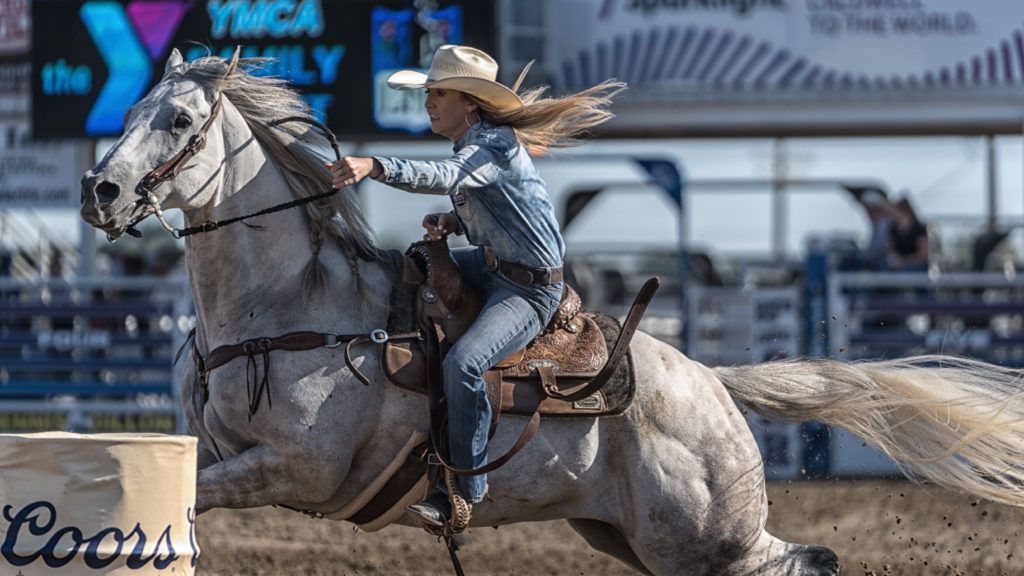
Bull Riding
One 2,000 pound animal paired against one 150 pound man ensures an adrenaline rush for those brave enough to climb in the chutes. The is a crowd favorite event at every single rodeo! To stay on, the rider grasps a flat braided rope or “bull rope” which is wrapped around the bull’s chest just behind its front legs. One end of the bull rope, called the “tail”, is threaded through the loop on the other end and fastened around the animal. The rider then wraps the tail around his hand holding the rope, sometimes weaving it through his fingers to further secure his grip.
When the chute gate opens riders must stay on for eight seconds, while a twisting, bucking mass of muscle tries anything to buck them off. If the contestant makes contact with the animal or themselves with their free hand, they receive no score.
Points are based on rider’s ability to stay on, as well as the bull’s bucking action. Extra points are awarded to those who are controlled enough to spur their bull with one or both of their dulled spurs. A high-scoring ride is in the high 80s or 90s out of a possible 100.

BREAKAWAY ROPING *NEW IN 2021*
In the breakaway roping event, a calf is loaded into the roping chute and the roper enters the box on the heelers side (right side). The roper waits in the corder until their horse is standing squarely and looking ahead.
The roper nods their head, the chute is opened and the calf is released into the arena. The roper’s horse runs behind the calf putting the roper in position to rope the calf around the neck.
When the calf is caught, the roper stops their horse abruptly, pulling the rope tight and breaking a small string that ties it to the saddle horn. This marks the end of the run and stops the clock.
